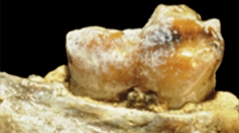

 Comptes Rendus Palevol
7 (8) - Pages 583-590
Comptes Rendus Palevol
7 (8) - Pages 583-590The Aramis Member (Sagantole formation) includes the Gàala Tuff Complex-Daam Aatu Basaltic Tuff interval which has produced a taxonomically diverse vertebrate assemblage including the primitive hominid Ardipithecus ramidus. New Eucyon remains recovered from this interval come from localities in the Aramis, Sagantole, and Kuseralee catchments. The chronology established for the GATC-DABT interval is 4.4 Ma. These recoveries represent the most abundant available Eucyon assemblage of the eastern African Pliocene. Here, Eucyon fossils from the Kapsomin and Lemudong’o Late Miocene Kenyan sites are compared with the Aramis representatives, showing comparable morphology although with smaller dimensions. E. intrepidus – E. wokari nov. sp., might constitute a single lineage, with increasing size and robusticity, and the derivation of some morphological traits mainly on the lower carnassial. E. wokari represents a new eastern species of the African Pliocene Eucyon lineage.
Canidae, Eucyon, Mio-Pliocene, Aramis, Middle Awash, Ethiopia